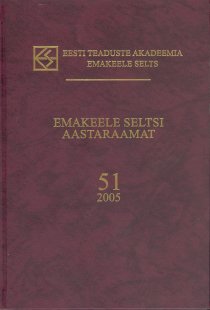Mittesufiksaalne deminutiivtuletus eesti keeles
Non-suffixal diminutive derivation in Estonian
Author(s): Petar Kehayov, Rogier BloklandSubject(s): Language and Literature Studies
Published by: Teaduste Akadeemia Kirjastus
Keywords: semantics; polysemy; word derivation; diminutive words; Estonian
Summary/Abstract: The article sets itself two specific aims: a) to list all types of non-suffixal diminutive derivation in Estonian, and b) to prove that the main function of these derivational mechanisms is to form diminutives. Types of non-suffixal diminutive derivation include insertion of i in inlaut (e.g. kukk ‘cock’ > kikas ‘id.’), between the stem and suffix (lipats ‘thin splinter’ > lipits ‘id.’), and in the suffix (? sula ‘soft’ > sulnis ‘sweet, delightful’); replacement of a non-palatalized consonant with ś (e.g. poeg ‘son’ > poiss ‘boy’); desuffixation (e.g. hobune ‘horse’ > hobu ‘id.’); lexicalization of the form of genitive (e.g. emm ‘mother’ > emme ‘id.’), and gemination (e.g. jõgi ‘river’ > jõkk ‘ditch’). A comparison of words formed thus with their base words confirms that the meanings acquired by the derivatives coincide with meanings in Jurafsky’s (1996) universal polysemous category of the diminutive, thereby proving that the above-mentioned derivational mechanisms produce diminutives. The derivatives recorded permit us to speak of a systematic, although at present barely productive, derivational rule in at least three cases: insertion of i in the stem, lexicalization of the genitive, and gemination. The most common meanings denoted by these derivational mechanisms are SMALL, SMALL TYPE OF, AFFECTION and IMITATION. The above-mentioned non-suffixal derivational mechanisms exhibit different degrees of typological universality. Whilst the derivation of diminutives with an i-element is common in the world’s languages, consonant gemination as a diminution device seems to occur only in Estonian. The three above-mentioned derivational mechanisms may be linked to morphophonological attrition in Estonian. Through this development the agglutinative character of Estonian morphology has become more fusional, with derivation losing part of its morphotactic transparency. As these three derivational mechanisms are morphotactically less transparent than suffixal derivation, they harmonize with the general direction of typological change in Estonian.
Journal: Emakeele Seltsi aastaraamat
- Issue Year: 2006
- Issue No: 52
- Page Range: 087-124
- Page Count: 38
- Language: Estonian

